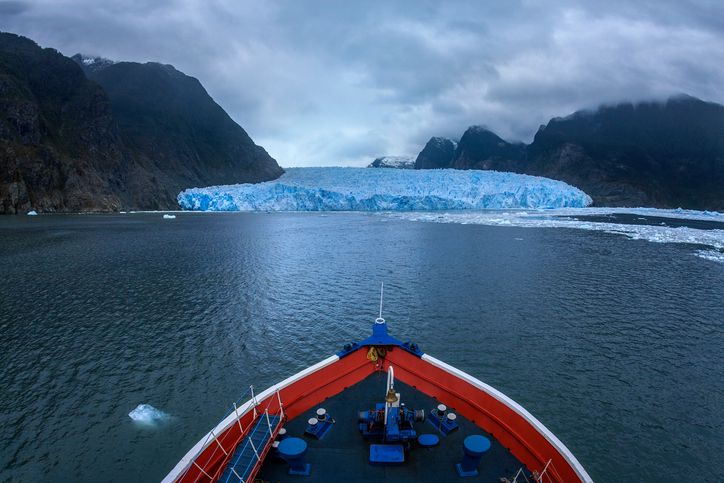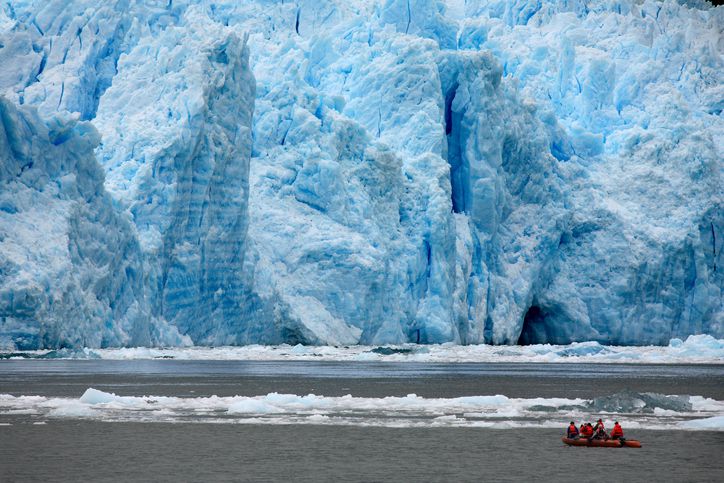Accessible by day trip from Río Tranquilo in the Aysén Region of Chile, the San Rafael Glacier is an unmissable highlight of Patagonia. Tourists throng to Laguna San Rafael to see the spectacular calving of ice from the glacier’s 230 ft. (70m) snout, leaving a jumble of icebergs bobbing in the frigid waters.
But this remarkable natural landmark is in danger of disappearing, meaning that those hoping to take a trip to the glacier should do so as soon as possible – before it’s too late.
The rapid retreat of glaciers in Patagonia
One of the main glaciers that flows from the Northern Patagonian Ice Field, San Rafael acts as an important indicator of the impact of global climate change on the region.
 Alongside other glaciers in the Northern Patagonian Ice Field, San Rafael is being closely monitored by Chilean climatologists, who’ve made the startling discovery that over 90% of all glaciers in Patagonia are retreating.
Alongside other glaciers in the Northern Patagonian Ice Field, San Rafael is being closely monitored by Chilean climatologists, who’ve made the startling discovery that over 90% of all glaciers in Patagonia are retreating.
Scientists from UK universities have also been researching changes to 270 glaciers in Argentina and Chile. They’ve found that glaciers have suffered a more rapid retreat and a greater loss of volume over the past 30 years than in any other time since the “Little Ice Age”, a glacial period that took place between the 16th and 19th-centuries.
Although levels of precipitation over the past 100 years have remained constant, scientists believe that the fault lies in temperature increases, which have had a profound – and irreversible – impact upon Patagonian glaciers.
The impact of rising temperatures on the San Rafael Glacier
San Rafael has retreated around 0.6-miles (1km) since the early 1990s. Over the past 136 years, it’s believed to have shrunk by 7.5-miles (12km).
 Not only does this raise huge concerns about the impact of glacial meltwater on the levels of the oceans, but for the local people in the Aysén Region, the rapid retreat of San Rafael Glacier will also have wide-ranging consequences.
Not only does this raise huge concerns about the impact of glacial meltwater on the levels of the oceans, but for the local people in the Aysén Region, the rapid retreat of San Rafael Glacier will also have wide-ranging consequences.
Scientists and local tourist agencies fear that soon the glacier will no longer feed directly into Laguna San Rafael, meaning that the main sight that brings tourists to the area – to see the calving of the ice into the lake – will no longer be visible. This could have a damaging impact on the local economy.
Key facts about the San Rafael Glacier:
- It is part of the Northern Patagonian Icefield which covers 1,620 sq.-miles (4,200km²). However, this ice sheet is far smaller than the Southern Patagonian Icefield, which covers 5,020 sq.-miles (13,000km²) and from which flow famous glaciers such as Upsala, Perito Moreno in Los Glaciares National Park, Grey in Torres del Paine National Park and Pío XI in the fjords of Chile.
- The San Rafael Glacier and the Northern and Southern icefields are what is left of the Patagonian Ice Sheet that covered the area during the most recent ice age, the Pleistocene, which lasted from 2,588,000 to 12,000 years ago.
- Scientists are very concerned about the rate of retreat of the San Rafael Glacier. At the end of the 19th-century, the glacier was recorded as being 6-miles (10km) further into the sea than at present time.
- Moraine left at what was once the glacier’s terminus, 7.5-miles (12km) from its present location, is believed to be between 3,000 and 5,000 years old. This has led scientists to the conclusion that the glacier remained stable until around 100 years ago, at which point it began a rapid retreat.
No comments yet
There are no comments on this post yet.






Leave a comment